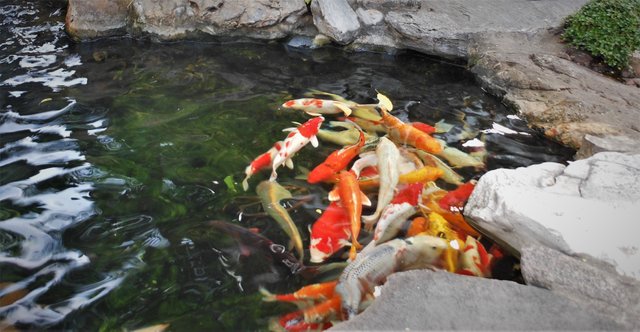A Guide To Focusing: Psychotherapy For Everyday Use
How To Apply Psychotherapy Principles In Everyday Life
This is an introduction to Focusing (wiki), an amazing psychotherapy method which has considerably improved my ability to cope with my emotions and difficult situations. First, you will learn where did Focusing come from, why should you use it, and what you need to do before you start. After that, I will guide you through the process of Focusing step by step.
.jpg)
Every suffering has a cause. Every suffering can be ceased.
A Very Brief History Of Focusing
Focusing originated from the research of American philosopher and psychologist Eugene Gendlin (1926 - 2017) during his collaboration with Carl Rogers (1902 - 1987), the "founding father" of psychotherapy. Gendlin wanted to find out why do some psychotherapy patients make better progress than others.
During the 50s and 60s, Gendlin discovered that the success of psychotherapy doesn't lie as much in the therapist and the technique, as it does in the patient's ability to look inside themselves, to be aware of a felt sense. He developed steps to teach people this successful behavior and later summarized them in his book Focusing (goodreads).
Focusing has since found its way into the mainstream of psychotherapy, either by therapists practicing the method itself, or by applying its principles in other methods. I have attended a one-week Focusing course in July 2012.
Why Use Focusing?
We are under constant influence of the events around us. The world seems to be runnig at faster and faster pace and our body is reacting to what is happening whether we notice it or not. Even if we want to take care of our mental health and perhaps meditate, when we actually get the chance to do so and look inside, it is like we enter a room full of misplaced furniture and garbage, and we are overwhelmed by the mere idea of having to make up that room.
Focusing does not aim at making up your room, at least not immediately. The goal #1 is just creating a place to sit in that room. Place from which we will at least be able to observe the mess without becoming frozen. A place to start.
You can also think of Focusing as a dfragmentation for your brain. It does not necessarily create more space, but it helps to make the existing problems less chaotic, it helps to put some pieces together. It is a tool to transform the overwhelming problems we might otherwise choose not to face, into smaller, digestable portions.
Before You Start
To benefit fully from the method, we have to first clarify some terminology and make a little preparation. The important words include:
- Felt Sense
It is not just a bodily sensation and it is not an emotion either. It is a lower-resolution information within our body, an unclear awareness of something inside we have not yet been able to put into words.
I like to think about a certain hierarchy of information depending on their clarity. On the highest step, there are thoughts so specific that we are able to put them into words. Just a little bit lower, we find thoughts which we might not be able to verbalize, but we understand them nevertheless. Below them, we find emotions - containing information so complicated that it is difficult for our body to form them into a thought, therefore the body communicates to us through emotions. The lowest level of resolution on which we store information can be perceived by bodily feelings. The felt sense aims to connect those levels vertically, and to help us form a connection between our feelings and our thoughts by creating "keywords" in order to work with them. In other words...
- Handle
The term regularly used in Focusing, meaning the keyword which symbolizes our felt sense.
- Felt Shift
The occurence of the felt sense changing due to the process of Focusing.
I have one more term to add. It does not come from the Focusing literature that I have read, but from the psychotherapist who conducted the Focusing course I attended. He called it:
- Your Place
Imagine a place where you feel at ease. It does not have to exist in the real world. Perhaps it is the garden of your dream house, perhaps it is the bottom of the ocean. When you dwell in that place, your heart feels warm and open. There is no negativity, no stress, no harmful influences of the outside world. Remember this place and how you feel when you rest there, you will need it later.

Come to me, all you who are weary and burdened, and I will give you rest.
Focusing Step By Step
The best results can be achieved when you have another person guide you through these steps, so you can give full attention to your feelings, while your guide takes care of the narrating. Focusing can be very intense experience. It might cause long-forgotten memories and suppressed emotions to surface, and the presense of someone else overseeing the situation can be very helpful.
If you feel confident enough in your ability to follow the whole process through while maintaining the focus on your inner sensations, you can also practice Focusing by yourself. Still, it is better if you at least have the experience of being guided through it first. Make sure you are not disturbed by anyone and try not to lose track of the time. The whole cycle should not take more than 30 minutes. You should, of course, find a comfortable position and you may want to close your eyes.
step 1
Imagine your consciousnes as a little source of light, perhaps a firefly, just behind your closed eyes. Now, let the light descend down into your body, through your throat and further down. Notice the feelings inside your body. Choose the strongest feeling, the one that seems the most urgent, and turn your focus towards it. Perhaps it's the itching in your left foot, perhaps it's the burning sensation in your chest.
step 2
Now you need to ask yourself several questions. Do not think about them. Answer the first thing that comes to your mind. There are no right or wrong answers. They do not have to make sense. Turn your attention back to the feeling in your body calling out to you.
Where is this feeling inside my body? "Scan" your body and clearly state which body parts seem to be the epicentre of this feeling.
What is this feeling like? Here comes the Handle. Say the keyword. It might be anything. Cold, sharp, green, slow... whatever seems to fit the sensation.
Am I able to be with this feeling? At first, this might seem as a dificult question. Don't worry, if you are not able to be with a feeling, you will notice. Concentrate on the feeling without any judgement.
Yes, I am able to be with this feeling. If that is the case, continue to the next question.
No, I am not able to be with this feeling. If you cannot look at the feeling or doing so makes you feel very uncomfortable, do not force yourself. Instead, remember Your place. The place where nothing can harm you, where you feel at peace. You are resting in that place. Suddenly, the uncomfortable feeling is coming towards you in the form of a little, innocent child. Can you allow this clueless being to come into your place and sit down next to you?
Yes, I think I can do that. Continue to the next question.
No, I will not allow this feeling to enter my place! How does this notion of not allowing it to enter your place make you feel? Are you able to be with this feeling? (...)
Does this feeling remind you of any event, memory, or perhaps a person? If an answer comes to your mind, say it, if you feel comfortable speeking. Simple yes or no is more than enough. Continue to watch your feeling.
Does the feeling seem any different now? Perhaps a felt shift occured. Turn your awareness towards this new feeling and repeat the same set of questions for as long as you like.
step 3
When you are happy with the progress, or wish to end the session for any reason, do not just open your eyes (if you had decided to close them) and walk away. First, create a final handle - let's call it the key, capturing the moment when you decided to wrap up the process. It might be a sentence, or a set of words. When you are going to be Focusing the next time, you might want to start by reminding yourself of this phrase.
step 4
Now it's time to thank your body for all the information it has showed you. It does not matter whether you think you have made progress or not. Being able to turn your attention inside your body, towards your feelings, is an achievement in itself. Be grateful for what you have just experienced.
When you feel ready, imagine that little source of light, that firefly, to rise from the inside your body, up through your throat, behind your eyes. The session is now finished.

I will instruct you and teach you in the way you should go
I will counsel you with my loving eye on you
But What If You Have No Time?
This is the most amazing thing about Focusing. Once you understand how the process works, you don't have to follow these steps very strictly. They should only provide you with guidance, not limit you to one possible way.
If you should learn just one thing, remember this: Every time you are faced with a difficult emotion, with a situation you are unable to process at that moment, instead of falling into anxious thoughts and hopelessness, simply ask, where is this feeling in my body?
Remind yourself that feelings and emotions don't have to be our prison, but we can instead use them as a tool. They are the language through which our body speaks to us. Deny your body the attention it needs, and it might have to call out to you with stronger, more direct language like disease. Do not make the mistake of noticing your own body's cry for help only when it's too late. Some problems might be avoided by just properly focusing.
Good luck on your journey!
This post has been resteemed from MSP3K courtesy of @isaria from the Minnow Support Project ( @minnowsupport ).
Bots Information:
Join the P.A.L. Discord | Check out MSPSteem | Listen to MSP-Waves
Hi @monoxid. I'm rewarding authors and followers like you who contribute authentic original content to steemit by adding their names to my upvote bot. You should see my upvote appear on most of your posts going forward. Thanks!
I have mixed feelings about bots... But they are probably mixed because the purpose of bots like yours doesn't seem so bad : )
Thank you!
I had misgivings too. I decided to find a way to use mine as a way to encourage people whose work I like (so hopefully they continue creating it instead of giving up or going over to the spammy dark side). Also, importantly, I use it as a way to revisit the work of people I had upvoted in the past - to stay in touch rather than "set and forget". If you ever feel like it bothers you, let me know and I'll turn it off. Thanks - Conrad.
I feel better already just from reading that. Here is a gif of me later today.
That looks like an amazing result. Thanks for letting me get a taste of that feeling as well!
This seems to be similar to mindfulness meditation, if one removes terminology differences, is it not?
Although the way some people experience those two things might be very similar, the terms are not interchangeable.
Mindfulness meditation is a very vague term. You can be mindful of anything, really, and you should not have any goal. On the other hand, Focusing is a very specific tool used for a very specific purpose: listening to your own feelings that need attention. It might sound like a contradiction, but I would say that Focusing is more active.
The terminology is one of the things that also make Focusing different. Most of the meditation techniques I heard/read about already expect you to have a certain level of experience, otherwise you can't easily get past the "be aware of your breathing" stage. But Focusing is aiming to help especially those people with really little experience to help them make sense of what is even happening.
Thank you for the detailed explanation. I missed the active part in Focusing, pursuing the goal. Although the meditation pundits would argue that one can achieve this goal, wellbeing and clarity, just by meditating.
I like that it can be tried by inexperienced person, looks like there some YouTube videos to get one started :)
This is very interesting. A good tool. The simple tools like this are the best. They seem obvious when you know them but hard to come up with them on your own. At some points in our lives and perhaps our cycle, we are overwhelmed by emotional states , effecting others left, right and centre. To know a quick retreat like this is a well needed coping mechanism. Thanks.
I completely agree. When I first encountered Foocusing, I thought, oh, this is so easy to do! Why do I even have to follow these steps? But in time, I realized, how much did those terms and techniques change the perception of my inner state of being. And how much are people surprised when I tell them that it's natural for me to see my feelings simply as information so complex I can't understand it with my brain.
Your Post Has Been Featured on @Resteemable!
Feature any Steemit post using resteemit.com!
How It Works:
1. Take Any Steemit URL
2. Erase
https://3. Type
reGet Featured Instantly – Featured Posts are voted every 2.4hrs
Join the Curation Team Here | Vote Resteemable for Witness